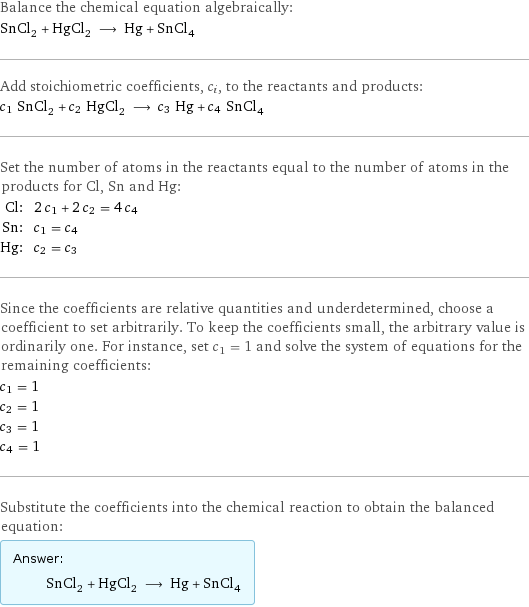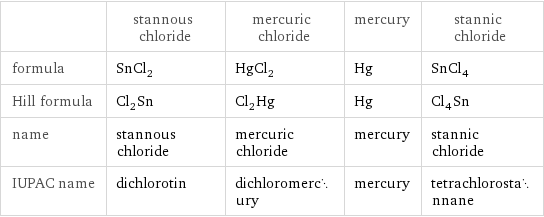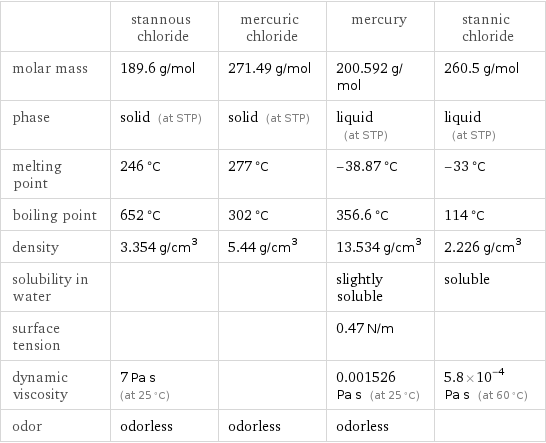Input interpretation

SnCl_2 stannous chloride + HgCl_2 mercuric chloride ⟶ Hg mercury + SnCl_4 stannic chloride
Balanced equation

Balance the chemical equation algebraically: SnCl_2 + HgCl_2 ⟶ Hg + SnCl_4 Add stoichiometric coefficients, c_i, to the reactants and products: c_1 SnCl_2 + c_2 HgCl_2 ⟶ c_3 Hg + c_4 SnCl_4 Set the number of atoms in the reactants equal to the number of atoms in the products for Cl, Sn and Hg: Cl: | 2 c_1 + 2 c_2 = 4 c_4 Sn: | c_1 = c_4 Hg: | c_2 = c_3 Since the coefficients are relative quantities and underdetermined, choose a coefficient to set arbitrarily. To keep the coefficients small, the arbitrary value is ordinarily one. For instance, set c_1 = 1 and solve the system of equations for the remaining coefficients: c_1 = 1 c_2 = 1 c_3 = 1 c_4 = 1 Substitute the coefficients into the chemical reaction to obtain the balanced equation: Answer: | | SnCl_2 + HgCl_2 ⟶ Hg + SnCl_4
Structures

+ ⟶ +
Names

stannous chloride + mercuric chloride ⟶ mercury + stannic chloride
Equilibrium constant
![Construct the equilibrium constant, K, expression for: SnCl_2 + HgCl_2 ⟶ Hg + SnCl_4 Plan: • Balance the chemical equation. • Determine the stoichiometric numbers. • Assemble the activity expression for each chemical species. • Use the activity expressions to build the equilibrium constant expression. Write the balanced chemical equation: SnCl_2 + HgCl_2 ⟶ Hg + SnCl_4 Assign stoichiometric numbers, ν_i, using the stoichiometric coefficients, c_i, from the balanced chemical equation in the following manner: ν_i = -c_i for reactants and ν_i = c_i for products: chemical species | c_i | ν_i SnCl_2 | 1 | -1 HgCl_2 | 1 | -1 Hg | 1 | 1 SnCl_4 | 1 | 1 Assemble the activity expressions accounting for the state of matter and ν_i: chemical species | c_i | ν_i | activity expression SnCl_2 | 1 | -1 | ([SnCl2])^(-1) HgCl_2 | 1 | -1 | ([HgCl2])^(-1) Hg | 1 | 1 | [Hg] SnCl_4 | 1 | 1 | [SnCl4] The equilibrium constant symbol in the concentration basis is: K_c Mulitply the activity expressions to arrive at the K_c expression: Answer: | | K_c = ([SnCl2])^(-1) ([HgCl2])^(-1) [Hg] [SnCl4] = ([Hg] [SnCl4])/([SnCl2] [HgCl2])](../image_source/8098702b927159b258ea727717647c9f.png)
Construct the equilibrium constant, K, expression for: SnCl_2 + HgCl_2 ⟶ Hg + SnCl_4 Plan: • Balance the chemical equation. • Determine the stoichiometric numbers. • Assemble the activity expression for each chemical species. • Use the activity expressions to build the equilibrium constant expression. Write the balanced chemical equation: SnCl_2 + HgCl_2 ⟶ Hg + SnCl_4 Assign stoichiometric numbers, ν_i, using the stoichiometric coefficients, c_i, from the balanced chemical equation in the following manner: ν_i = -c_i for reactants and ν_i = c_i for products: chemical species | c_i | ν_i SnCl_2 | 1 | -1 HgCl_2 | 1 | -1 Hg | 1 | 1 SnCl_4 | 1 | 1 Assemble the activity expressions accounting for the state of matter and ν_i: chemical species | c_i | ν_i | activity expression SnCl_2 | 1 | -1 | ([SnCl2])^(-1) HgCl_2 | 1 | -1 | ([HgCl2])^(-1) Hg | 1 | 1 | [Hg] SnCl_4 | 1 | 1 | [SnCl4] The equilibrium constant symbol in the concentration basis is: K_c Mulitply the activity expressions to arrive at the K_c expression: Answer: | | K_c = ([SnCl2])^(-1) ([HgCl2])^(-1) [Hg] [SnCl4] = ([Hg] [SnCl4])/([SnCl2] [HgCl2])
Rate of reaction
![Construct the rate of reaction expression for: SnCl_2 + HgCl_2 ⟶ Hg + SnCl_4 Plan: • Balance the chemical equation. • Determine the stoichiometric numbers. • Assemble the rate term for each chemical species. • Write the rate of reaction expression. Write the balanced chemical equation: SnCl_2 + HgCl_2 ⟶ Hg + SnCl_4 Assign stoichiometric numbers, ν_i, using the stoichiometric coefficients, c_i, from the balanced chemical equation in the following manner: ν_i = -c_i for reactants and ν_i = c_i for products: chemical species | c_i | ν_i SnCl_2 | 1 | -1 HgCl_2 | 1 | -1 Hg | 1 | 1 SnCl_4 | 1 | 1 The rate term for each chemical species, B_i, is 1/ν_i(Δ[B_i])/(Δt) where [B_i] is the amount concentration and t is time: chemical species | c_i | ν_i | rate term SnCl_2 | 1 | -1 | -(Δ[SnCl2])/(Δt) HgCl_2 | 1 | -1 | -(Δ[HgCl2])/(Δt) Hg | 1 | 1 | (Δ[Hg])/(Δt) SnCl_4 | 1 | 1 | (Δ[SnCl4])/(Δt) (for infinitesimal rate of change, replace Δ with d) Set the rate terms equal to each other to arrive at the rate expression: Answer: | | rate = -(Δ[SnCl2])/(Δt) = -(Δ[HgCl2])/(Δt) = (Δ[Hg])/(Δt) = (Δ[SnCl4])/(Δt) (assuming constant volume and no accumulation of intermediates or side products)](../image_source/ff239f324e64519fd2a121fd4bdb77e6.png)
Construct the rate of reaction expression for: SnCl_2 + HgCl_2 ⟶ Hg + SnCl_4 Plan: • Balance the chemical equation. • Determine the stoichiometric numbers. • Assemble the rate term for each chemical species. • Write the rate of reaction expression. Write the balanced chemical equation: SnCl_2 + HgCl_2 ⟶ Hg + SnCl_4 Assign stoichiometric numbers, ν_i, using the stoichiometric coefficients, c_i, from the balanced chemical equation in the following manner: ν_i = -c_i for reactants and ν_i = c_i for products: chemical species | c_i | ν_i SnCl_2 | 1 | -1 HgCl_2 | 1 | -1 Hg | 1 | 1 SnCl_4 | 1 | 1 The rate term for each chemical species, B_i, is 1/ν_i(Δ[B_i])/(Δt) where [B_i] is the amount concentration and t is time: chemical species | c_i | ν_i | rate term SnCl_2 | 1 | -1 | -(Δ[SnCl2])/(Δt) HgCl_2 | 1 | -1 | -(Δ[HgCl2])/(Δt) Hg | 1 | 1 | (Δ[Hg])/(Δt) SnCl_4 | 1 | 1 | (Δ[SnCl4])/(Δt) (for infinitesimal rate of change, replace Δ with d) Set the rate terms equal to each other to arrive at the rate expression: Answer: | | rate = -(Δ[SnCl2])/(Δt) = -(Δ[HgCl2])/(Δt) = (Δ[Hg])/(Δt) = (Δ[SnCl4])/(Δt) (assuming constant volume and no accumulation of intermediates or side products)
Chemical names and formulas

| stannous chloride | mercuric chloride | mercury | stannic chloride formula | SnCl_2 | HgCl_2 | Hg | SnCl_4 Hill formula | Cl_2Sn | Cl_2Hg | Hg | Cl_4Sn name | stannous chloride | mercuric chloride | mercury | stannic chloride IUPAC name | dichlorotin | dichloromercury | mercury | tetrachlorostannane
Substance properties

| stannous chloride | mercuric chloride | mercury | stannic chloride molar mass | 189.6 g/mol | 271.49 g/mol | 200.592 g/mol | 260.5 g/mol phase | solid (at STP) | solid (at STP) | liquid (at STP) | liquid (at STP) melting point | 246 °C | 277 °C | -38.87 °C | -33 °C boiling point | 652 °C | 302 °C | 356.6 °C | 114 °C density | 3.354 g/cm^3 | 5.44 g/cm^3 | 13.534 g/cm^3 | 2.226 g/cm^3 solubility in water | | | slightly soluble | soluble surface tension | | | 0.47 N/m | dynamic viscosity | 7 Pa s (at 25 °C) | | 0.001526 Pa s (at 25 °C) | 5.8×10^-4 Pa s (at 60 °C) odor | odorless | odorless | odorless |
Units
